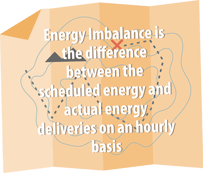- Home
- Services
- Hi-Line Engineering
- About
- Careers
- Contact
- Requests For Proposals
EAST MEETS WEST - The Energy Imbalance Market Gold Rush
by GDS Associates, Inc | November 20, 2019 | News , Uncategorized , Newsletter - TransActions
One hundred seventy years after folks from the East came West to find their fortunes in the mountains and streams of California, a new migration is occurring in the electricity sector– the energy imbalance market. Right now, two groups are staking their claim to be the dominant player in addressing real-time energy imbalances in the Western Interconnect. Why is energy imbalance service of such interest in the Western region? Doesn’t the open access transmission tariff already address this issue? Isn’t in-kind repayment of energy imbalances good enough? Why should I care? This article takes a look at the fundamentals of real-time energy imbalances and what it means for electric utilities in the Western Interconnect.
WHAT IS ENERGY IMBALANCE?
 Energy imbalance is the difference between the scheduled energy and actual energy deliveries on an hourly basis. This is commonly referred to as Schedule 4 in the Open Access Transmission Tariff (OATT). This differs from regulation and frequency response, which is Schedule 3 under the tariff, as regulation deals with instantaneous deviations. Energy Imbalance Service is applied whenever a generator deviates from its generation schedule. If the generator is dispatched more than the amount scheduled, the generator collects revenue from the Transmission Provider for the excess generation. If the generator is dispatched less than the amount scheduled, the Transmission Provider charges the generator for the deficit. The price signal for these excursions is usually based on the Transmission Provider’s incremental and decremental costs and the generator incurs financial penalties if the deviations are too large.
Energy imbalance is the difference between the scheduled energy and actual energy deliveries on an hourly basis. This is commonly referred to as Schedule 4 in the Open Access Transmission Tariff (OATT). This differs from regulation and frequency response, which is Schedule 3 under the tariff, as regulation deals with instantaneous deviations. Energy Imbalance Service is applied whenever a generator deviates from its generation schedule. If the generator is dispatched more than the amount scheduled, the generator collects revenue from the Transmission Provider for the excess generation. If the generator is dispatched less than the amount scheduled, the Transmission Provider charges the generator for the deficit. The price signal for these excursions is usually based on the Transmission Provider’s incremental and decremental costs and the generator incurs financial penalties if the deviations are too large.
HOW DOES ENERGY WORK IN AN ORGANIZED MARKET?
In the Eastern Interconnect, the energy imbalance is monetized using locational marginal prices, or LMP. The LMP represents the cost to serve the next megawatt of load at a particular location on the transmission system and includes congestion and losses. In organized markets using LMPs, there are additional charges and revenues when load and generation deviates from its hourly projection. Revenue received from entities that contribute to a system generation deficit by consuming more load than forecasted and generating less energy than scheduled is paid to the entities that made up the generation deficit by consuming less load and generating more energy. The significant penetration of variable energy resources (VERs), such as wind and solar, in recent years has greatly contributed to operational difficulties in managing the real-time deviations. Settling energy imbalances through physical repayment of energy may not fully compensate utilities for the cost of real-time deviations. That is, energy provided in one day is going to be more or less valuable than energy provided on another day because of real-time system conditions. Additionally, settling imbalance via Schedule 4 does not account VER contributions to transmission congestion. The LMP construct provides greater opportunity to monetize the impact of VERs and the operational risk associated with these nontraditional resources.
IS LMP-BASED ENERGY IMBALANCE USED IN THE WESTERN INTERCONNECTIONS?
 Yes, in the Western Interconnect, the California Independent System Operator (CAISO) uses an LMP based energy imbalance market. CAISO has expanded its services through the Western Energy Imbalance Market (Western EIM). Prior to the Western EIM, utilities settled daily imbalances through their interchange accounts. Physical repayment of deviations occurred based on bilateral arrangements and were used to reduce the size of the inadvertent account rather than eliminating any imbalances. As the Western EIM expanded across the footprint, the benefits of having a real-time price signal for generator and load deviations was increased. According to the Western EIM, its participants have seen a combined savings of $734 million since November of 2014.
Yes, in the Western Interconnect, the California Independent System Operator (CAISO) uses an LMP based energy imbalance market. CAISO has expanded its services through the Western Energy Imbalance Market (Western EIM). Prior to the Western EIM, utilities settled daily imbalances through their interchange accounts. Physical repayment of deviations occurred based on bilateral arrangements and were used to reduce the size of the inadvertent account rather than eliminating any imbalances. As the Western EIM expanded across the footprint, the benefits of having a real-time price signal for generator and load deviations was increased. According to the Western EIM, its participants have seen a combined savings of $734 million since November of 2014.
WHAT IS AN EIM?
The EIM facilitates resource integration on a larger footprint across the participating BAs. It allows load serving entities to purchase power in a much easier and more transparent manner, and by the same token, it allows generation resources to sell power in an easier manner. It also allows the real-time variations in supply and demand to be accommodated more efficiently and economically using a production cost security constrained model that maintains reliability while providing lower overall power cost via a competitive market. EIM does not require any transmission system upgrades, however expansion of transmission system will improve the costs of operating in the EIM environment. Aside from the economic benefits, operating in an EIM comes with a series of prerequisites and requirements. This includes implementing the appropriate metering and communication facilities as well as testing of resources to demonstrate the ability to provide energy and ancillary services. Loads and generation resources from each participating BA must be registered in the EIM. Participants must submit daily load forecasts and generation resources must provide availability and generation pricing offers. Additionally, operating the EIM requires maintaining detailed transmission system models, commonly referred to as Network Models, and the ability to dispatch the system in real-time. It also requires a robust energy accounting system to handle real-time pricing analysis and market settlements per specific timelines and processes. As proposed, the Western EIM will not be a coordinated Regional Transmission Organization (RTO) but could achieve most of the economic benefits that integration in an RTO would offer. Participation in the EIM is voluntary and utilities retain operational control over their assets and systems.
WHO ARE THE TWO GROUPS OFFERING REAL-TIME EIM IN THE WEST?
In the western corner, there is the CAISO and the Eastern expansion of the Western EIM. CAISO in its role of Independent System Operator balancing authority (ISO BA) is operating as a sole BA through an energy trading platform that balances supply and demand in real-time. CAISO started the Western EIM in 2014 with PacifiCorp being its first member BA. In the beginning, resources were only dispatched across the CAISO and PacifiCorp BA areas Currently, the Western EIM includes several participants: Arizona Public Service, Balancing Authority of Northern California (BANC), Idaho Power, NV Energy, PacifiCorp, Portland General Electric, Powerex, and Puget Sound Energy. From the East, the Southwest Power Pool (SPP) is offering an energy imbalance system to compete with the CAISO model. The SPP westward expansion is partially driven by being landlocked through its borders with MISO and ERCOT. However, SPP brings significant experience as they operated an Energy Imbalance Service (EIS) market since 2007, then in 2014 convert to a full integrated market by introducing the day-ahead unit commitment and additional services. In a similar fashion by which SPP operates in the Eastern Interconnect, its Western Energy Imbalance Service market (WEIS) will balance generation and load in real time, dispatching energy to meet demand every five minutes. In September 2019, Basin Electric Power Cooperative, Tri-State G&T, and Western Area Power Administration announced their participation in the SPP WEIS. SPP WEIS will be launching in February 2021. Besides the WEIS, SPP plans to provide its Western participants with additional contract-based products such as Reliability Coordination (launching in December 2019) and Planning Coordination services.
 WHAT SHOULD WESTERN UTILITIES DO?
WHAT SHOULD WESTERN UTILITIES DO?
For starters, become informed regarding these EIM opportunities and determine if participation in an EIM makes sense for your organization. Look for opportunities to become engaged in the various stakeholder processes to see how you can leverage the EIM dierences to your competitive advantage. Gather more information on all aspects of the EIMs including design, operation, scheduling, and settlements, as well as any negative impacts. Assess the changes in the utilization of the transmission system, how the EIM will dispatch your generation resources, and how those changes can aect your daily operation. Other important elements to consider are understanding the drivers that could impact energy prices, identifying resource capabilities and the cost of production, as well as the cost and eort to create and manage the EIM. Lastly, seek wise counsel from others who have been involved in similar processes and could assist with helping you navigate the new energy gold rush. Happy prospecting!
For more information or to comment on this article, please contact:
 John Chiles, Principal | CONTACT
John Chiles, Principal | CONTACT
GDS Associates, Inc. – Marietta, GA
770.799.2423 or john.chiles@gdsassociates.com
GET OUR NEWSLETTER
RECENT POSTS
Archives
- December 2015 (8)
- January 2016 (6)
- July 2016 (6)
- March 2021 (6)
- May 2022 (6)
- August 2020 (5)
- March 2015 (4)
- January 2019 (4)
- June 2019 (4)
- August 2019 (4)
- February 2020 (4)
- May 2020 (4)
- June 2020 (4)
- December 2020 (4)
- July 2021 (4)
- October 2021 (4)
- April 2015 (3)
- August 2016 (3)
- February 2017 (3)
- July 2017 (3)
- February 2018 (3)
- February 2019 (3)
- November 2019 (3)
- March 2020 (3)
- April 2020 (3)
- September 2021 (3)
- December 2021 (3)
- August 2022 (3)
- December 2022 (3)
- April 2023 (3)
- July 2023 (3)
- December 2023 (3)
- May 2014 (2)
- February 2016 (2)
- March 2016 (2)
- September 2016 (2)
- November 2016 (2)
- January 2017 (2)
- July 2018 (2)
- November 2018 (2)
- March 2019 (2)
- May 2019 (2)
- July 2020 (2)
- September 2020 (2)
- April 2021 (2)
- August 2021 (2)
- February 2014 (1)
- April 2014 (1)
- July 2014 (1)
- August 2014 (1)
- November 2014 (1)
- February 2015 (1)
- May 2015 (1)
- June 2015 (1)
- November 2015 (1)
- October 2016 (1)
- December 2016 (1)
- October 2018 (1)
- December 2018 (1)
- April 2019 (1)
- July 2019 (1)
- September 2019 (1)
- October 2020 (1)
- November 2020 (1)
- February 2021 (1)
- April 2022 (1)
- July 2022 (1)
- October 2022 (1)
- August 2023 (1)
- October 2023 (1)
- April 2024 (1)
Categories
- News (78)
- Newsletter - TransActions (75)
- Employee Spotlight (35)
- Energy Use & Efficiency (27)
- Environment & Safety (10)
- Other Specialized Services (8)
- Transmission (7)
- Cyber Security (4)
- Energy Supply (4)
- Power Supply (4)
- Hi-Line: Utility Distribution Services (3)
- Uncategorized (2)
- Utility Rates (2)
- Agriculture (1)
- Hi-Line: Seminars & Testing (1)